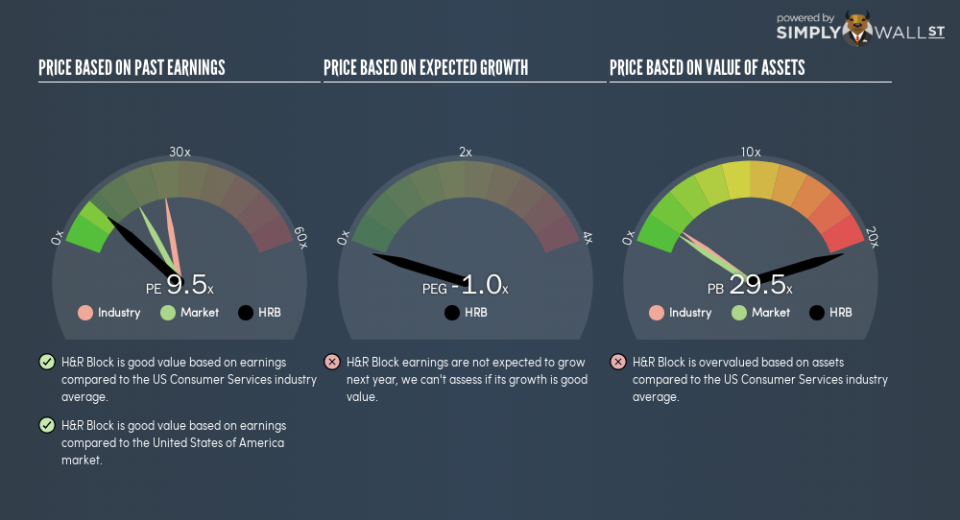Is H&R Block Inc’s (NYSE:HRB) P/E Ratio Really That Good?

This article is written for those who want to get better at using price to earnings ratios (P/E ratios). To keep it practical, we’ll show how H&R Block Inc’s (NYSE:HRB) P/E ratio could help you assess the value on offer. H&R Block has a price to earnings ratio of 9.5, based on the last twelve months. That means that at current prices, buyers pay $9.5 for every $1 in trailing yearly profits.
Check out our latest analysis for H&R Block
How Do You Calculate A P/E Ratio?
The formula for price to earnings is:
Price to Earnings Ratio = Share Price ÷ Earnings per Share (EPS)
Or for H&R Block:
P/E of 9.5 = $27.52 ÷ $2.9 (Based on the year to July 2018.)
Is A High P/E Ratio Good?
A higher P/E ratio implies that investors pay a higher price for the earning power of the business. All else being equal, it’s better to pay a low price — but as Warren Buffett said, ‘It’s far better to buy a wonderful company at a fair price than a fair company at a wonderful price.’
How Growth Rates Impact P/E Ratios
Earnings growth rates have a big influence on P/E ratios. That’s because companies that grow earnings per share quickly will rapidly increase the ‘E’ in the equation. Therefore, even if you pay a high multiple of earnings now, that multiple will become lower in the future. Then, a lower P/E should attract more buyers, pushing the share price up.
Notably, H&R Block grew EPS by a whopping 47% in the last year. And earnings per share have improved by 7.0% annually, over the last five years. I’d therefore be a little surprised if its P/E ratio was not relatively high.
How Does H&R Block’s P/E Ratio Compare To Its Peers?
The P/E ratio indicates whether the market has higher or lower expectations of a company. The image below shows that H&R Block has a lower P/E than the average (26) P/E for companies in the consumer services industry.
This suggests that market participants think H&R Block will underperform other companies in its industry. While current expectations are low, the stock could be undervalued if the situation is better than the market assumes. If you consider the stock interesting, further research is recommended. For example, I often monitor director buying and selling.
Remember: P/E Ratios Don’t Consider The Balance Sheet
Don’t forget that the P/E ratio considers market capitalization. In other words, it does not consider any debt or cash that the company may have on the balance sheet. In theory, a company can lower its future P/E ratio by using cash or debt to invest in growth.
Such expenditure might be good or bad, in the long term, but the point here is that the balance sheet is not reflected by this ratio.
Is Debt Impacting H&R Block’s P/E?
H&R Block’s net debt is 9.0% of its market cap. So it doesn’t have as many options as it would with net cash, but its debt would not have much of an impact on its P/E ratio.
The Verdict On H&R Block’s P/E Ratio
H&R Block has a P/E of 9.5. That’s below the average in the US market, which is 18. The EPS growth last year was strong, and debt levels are quite reasonable. If the company can continue to grow earnings, then the current P/E may be unjustifiably low.
Investors have an opportunity when market expectations about a stock are wrong. As value investor Benjamin Graham famously said, ‘In the short run, the market is a voting machine but in the long run, it is a weighing machine.’ So this free report on the analyst consensus forecasts could help you make a master move on this stock.
But note: H&R Block may not be the best stock to buy. So take a peek at this free list of interesting companies with strong recent earnings growth (and a P/E ratio below 20).
To help readers see past the short term volatility of the financial market, we aim to bring you a long-term focused research analysis purely driven by fundamental data. Note that our analysis does not factor in the latest price-sensitive company announcements.
The author is an independent contributor and at the time of publication had no position in the stocks mentioned. For errors that warrant correction please contact the editor at editorial-team@simplywallst.com.

 Yahoo Finance
Yahoo Finance 
